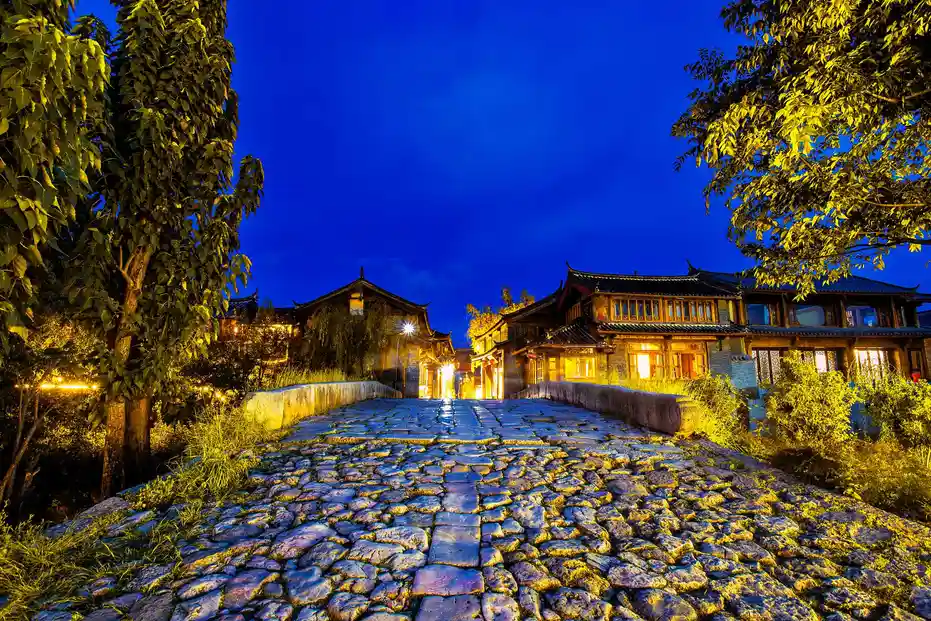Discover the Magic of Shuhe Ancient Town
If you’re searching for charm, culture, and quiet beauty in Yunnan, look no further than Shuhe Ancient Town. Tucked between Lijiang and the Jade Dragon Snow Mountain, this hidden gem offers a slower pace and fewer crowds than its famous neighbor. While many travelers rush to Lijiang Old Town, Shuhe remains a peaceful retreat with centuries-old cobbled streets and traditional Naxi architecture.
This article reveals the lesser-known spots in Shuhe Ancient Town that most tourists miss. From quiet tea houses to hidden temples and local artisan workshops, we’ll guide you through the authentic side of this historic destination. Whether you’re planning a trip or just dreaming of one, these insights will help you explore Shuhe like a local.
You won’t find flashy souvenir shops or crowded alleys here—at least not in the spots we’re sharing. Instead, expect warm smiles, handcrafted goods, and moments of stillness in a world that often moves too fast. Let’s begin the journey.
Why Shuhe Stands Out Among Yunnan’s Ancient Towns
Yunnan is home to many ancient towns, but Shuhe has a unique character. Unlike Dali or Lijiang, it balances preservation with everyday life. Locals still live in traditional homes, farm nearby fields, and gather in courtyards just as their ancestors did.
The town dates back over 1,000 years and was once a key stop on the Tea-Horse Road. This ancient trade route connected China with Tibet, and Shuhe thrived as a rest point for caravans. You can still see remnants of stone horse paths and old inns today.
What makes Shuhe special is its authenticity. While other towns cater heavily to tourists, Shuhe maintains a sense of daily rhythm. Children play near canals, elders sip tea in courtyards, and artisans work without performing for cameras.
This quiet authenticity is why Shuhe Ancient Town deserves more attention. It’s not just a place to visit—it’s a place to feel.
Explore the Tea-Horse Road Legacy
The Tea-Horse Road shaped Shuhe’s history. Traders carried tea from Yunnan to Tibet in exchange for horses. Shuhe sat at a strategic crossroads, making it a bustling hub in the 14th century.
Walk along the old stone paths and imagine mule caravans passing through. Some sections of the original route still exist, especially near the eastern entrance of the town. Look for worn grooves in the stones—evidence of centuries of foot and hoof traffic.
Several small museums in Shuhe tell the story of this trade network. One, run by a local historian, displays old maps, tea bricks, and caravan gear. It’s not flashy, but it’s heartfelt.
If you love history, take a guided walk focused on the Tea-Horse Road. Many local guides offer short tours in English. These walks often include stories of bandits, traders, and the risks of crossing high mountain passes.
Must-Visit Spots Along the Ancient Route
– **Old Inn Site**: Once a resting place for traders. Now a quiet courtyard with tea service.
– **Stone Bridge**: Crosses a clear stream. Great for photos at sunrise.
– **Tea Horse Museum**: Small but rich in local artifacts. Free entry.
– **Caravan Path Trail**: A 30-minute walk to the outskirts. Offers mountain views.
This heritage is part of what makes Shuhe Ancient Town more than just a pretty face. It’s a living museum of trade, culture, and survival.
Visit the Quiet Temples Off the Beaten Path
While Shuhe doesn’t have grand temples like in Beijing or Xi’an, its smaller religious sites are deeply meaningful. Most are tucked down narrow lanes, away from main streets.
One such place is the **Sanyi Temple**, dedicated to the Naxi people’s blend of Taoism, Buddhism, and indigenous beliefs. The temple is modest, with a red gate and a small courtyard. Locals come to burn incense and pray for health or good harvests.
Another hidden spot is the **Wenchang Pavilion**, perched on a slight hill. It offers a peaceful view of the town and surrounding fields. Few tourists climb up, making it a perfect place to sit and reflect.
These temples aren’t just for worship—they’re part of daily life. You might see an elder sweeping leaves or a family leaving offerings. Respect the space: speak softly and avoid flash photography.
Temple Etiquette Tips
– Walk clockwise around prayer wheels.
– Don’t point at statues or altars.
– Remove hats and shoes if entering inner halls.
– Ask before photographing people praying.
Visiting these quiet temples gives you a deeper understanding of Shuhe’s soul.
Find Local Artisans in Hidden Workshops
One of the best ways to experience Shuhe Ancient Town is through its craftspeople. Unlike mass-produced souvenirs, handmade goods here carry stories.
Look for small workshops tucked behind wooden doors. Many artisans don’t advertise—just a sign in Naxi script or a rack of leather goods near the entrance.
You’ll find:
– **Leatherworkers**: Crafting bags and belts using age-old techniques.
– **Dongba artists**: Painting sacred symbols used in Naxi religion.
– **Weavers**: Creating colorful scarves on handlooms.
– **Pottery makers**: Firing clay in small kilns near the river.
Spend time talking with them. Many speak basic English and enjoy sharing their process. Buying directly supports their craft and keeps traditions alive.
How to Spot Authentic Handmade Goods
| Feature | Mass-Produced | Handmade |
|---|---|---|
| Stitching | Even, machine-made | Slight variations |
| Materials | Synthetic fabrics | Natural fibers |
| Price | Very low | Fair, reflects labor |
| Origin | Factory-made | Made on-site |
Supporting local artisans is one of the most meaningful ways to travel.
Sip Tea in a Hidden Courtyard Café
Tea culture runs deep in Shuhe. But skip the chain-style cafés near the entrance. Instead, seek out the hidden courtyard spots known only to locals and long-term visitors.
One favorite is **Green Willow Tea House**, tucked down a narrow lane behind the post office. No sign, just a green door with a bell. Inside, a Naxi grandmother serves pu-erh tea in hand-thrown cups.
Another gem is **Cloud Rest Pavilion**, a two-story house with a rooftop terrace. From here, you can see rooftops stretching toward the mountains. They serve yarrow tea, known for calming nerves.
These places don’t appear on most maps. Ask your guesthouse host or a friendly shopkeeper for directions. A simple “Where do you go for tea?” often leads to the best spots.
Tea Types to Try in Shuhe
– **Pu-erh**: Aged, earthy, and rich.
– **Jasmine**: Light and floral.
– **Yarrow**: Herbal, slightly bitter, good for digestion.
– **Chrysanthemum**: Sweet and cooling.
Drinking tea here isn’t just about flavor—it’s about slowing down and connecting.
Walk the Secret Canals at Dawn
Shuhe is built around a network of canals that carry water from the mountains. By day, they’re charming. But at dawn, they’re magical.
Wake up early—around 6:30 AM. The town is quiet. Mist floats above the water. Ducks glide past stone bridges. You might see a farmer leading goats or a woman washing vegetables by the canal.
The main canal runs through the center, but the smaller side channels are more peaceful. Follow the narrow paths behind the market street. You’ll pass moss-covered walls and blooming azaleas.
Bring a camera, but also take time to just listen. The sound of flowing water, birds, and distant bells creates a natural symphony.
This is when Shuhe Ancient Town feels truly alive—not for tourists, but for itself.
Taste Local Flavors at the Morning Market
Food is a window into culture. In Shuhe, the morning market offers a taste of real Naxi life.
Arrive by 7:00 AM to see vendors setting up. The air fills with the smell of grilled meats, fresh herbs, and warm bread. Look for:
– **Naxi sausages**: Smoky and slightly spicy.
– **Guobasi**: A flaky fried pastry, often stuffed with meat or egg.
– **Yak yogurt**: Thick, tangy, and served in bamboo cups.
– **Wild mushrooms**: Seasonal, foraged from nearby forests.
Many stalls don’t have English signs. Pointing and smiling works fine. Vendors are used to curious travelers.
Sit at a small table and eat like a local. A full breakfast here costs less than $2. It’s not fancy, but it’s honest and delicious.
Stay in a Traditional Courtyard Guesthouse
Where you sleep shapes your experience. In Shuhe Ancient Town, courtyard guesthouses offer comfort and culture.
These homes are built in the Naxi style—wooden beams, tiled roofs, and central courtyards. Many have been passed down for generations and recently updated with modern bathrooms.
Staying in one means:
– Waking to birdsong, not traffic.
– Drinking tea in a private garden.
– Learning from hosts who know the town’s secrets.
Avoid big hotels near the main gate. Instead, book a place in the quieter western or northern sections.
Top Features of a Great Courtyard Stay
– Wooden architecture with carvings
– Shared or private courtyard
– Hosts who speak some English
– Quiet location, away from main roads
A good guesthouse doesn’t just give you a bed—it gives you a home.
Final Thoughts: Why You Should Visit Shuhe
Shuhe Ancient Town isn’t just another stop on the tourist trail. It’s a place where history, culture, and daily life blend seamlessly. While Lijiang draws the crowds, Shuhe offers something rarer: authenticity.
From hidden temples to artisan workshops and quiet morning walks, the real magic lies in the details. These hidden gems aren’t marked on maps—they’re discovered through curiosity and respect.
When you visit, take your time. Talk to locals. Sip tea. Wander without a plan. Let the town reveal itself to you.
And if you’re planning a trip to Yunnan, make Shuhe a priority. It may not be the most famous ancient town, but for many, it becomes the most memorable.
Travel slow. Stay curious. And don’t miss the quiet beauty of Shuhe.



